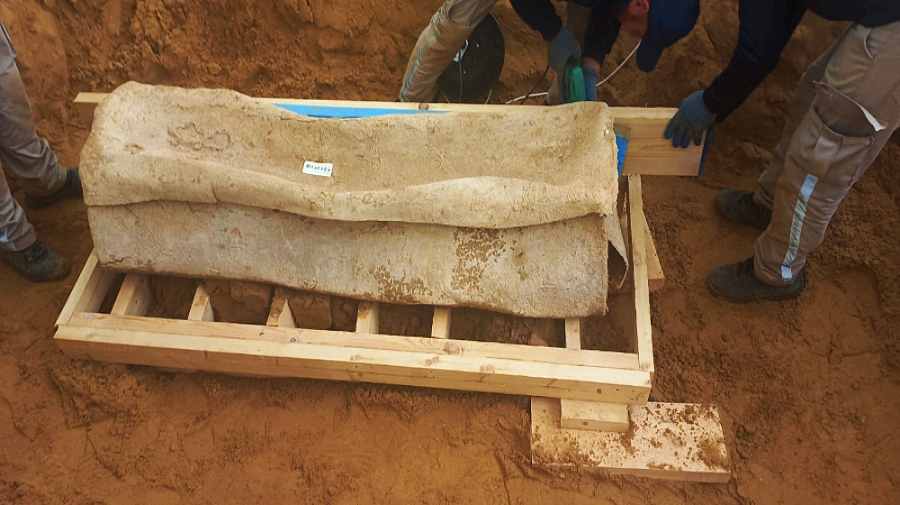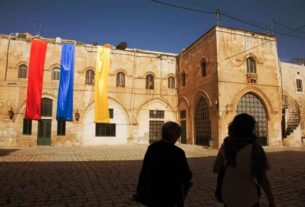Sun 26 February 2023:
The Palestinian Antiquities Ministry announced the discovery of a Roman-era coffin at the site of a 2,000-year-old Roman Cemetery which was unearthed last year in the northern Gaza Strip
Deep in the heart of the hotly contested Palestinian strip of Gaza, a 2,000-year-old lead sarcophagus has been unearthed, believed to hail from the illustrious Roman era. Located just 500 meters (0.3 miles) from the beautiful northern Gaza coastline, the Roman necropolis in this region is a precious cultural gem for Palestine, and the recent discovery of this sarcophagus has added another sparkling jewel to its crown.
According to Jehad Yasin, the Director of Excavation and Museums for the Palestinian Ministry of Tourism and Antiquities, the lead sarcophagus’s position within the necropolis suggests that it belonged to a prominent member of the elite. Such a discovery could provide a tantalizing glimpse into the glamorous lifestyles of the past.
Roman-era sarcophagus uncovered in the northern Gaza Strip pic.twitter.com/XO8GVNMwQi
— INDEPENDENT PRESS (@IpIndependent) February 26, 2023
Lead Sarcophagus Belonged to a Prominent Figure
“Our teams discovered the sarcophagus, made out of lead, last Tuesday,” explained Tariq al-Aff, the ministry’s spokesperson, in The New Arab . “It belonged to an important figure of that era. We have not opened the tomb as we placed it in a protective wooden container for further study by Palestinian and international experts,” he added when discussing the lead sarcophagus unearthed in Gaza.
The ancient Roman cemetery was discovered in 2022, as part of a joint excavation carried out at the site in collaboration with Premiere Urgence Internationale and funded by the British Council. Premiere Urgence Internationale, a French humanitarian organization, has partnered with Gaza on a project called INTIQAL, focused on preserving Palestinian cultural heritage. The state of preservation of the lead sarcophagus is exceptional, as it remained sealed and closed.
The Difficulty of Preserving Palestinian Cultural Heritage
The lead sarcophagus has been carefully extracted from the site and is currently undergoing an intensive two-month archaeological analysis, as experts strive to identify the bones within. With great anticipation, a team of specialists will soon unseal the ancient coffin to unveil its mysterious contents.
Remarkably, despite the tumultuous history of Gaza – a region subject to frequent aerial bombardment and a blockade enforced by Israeli and Egyptian authorities – the sarcophagus has remained remarkably preserved and intact.
WATCH: This Roman-era sarcophagus was uncovered in Gaza at the site of a 2,000-year-old Roman cemetery. It’s believed to have belonged to a high-profile figure https://t.co/WFmuIW1n1X pic.twitter.com/AtkWxhTyFF
— Reuters (@Reuters) February 19, 2023
Since its discovery last year, French and Palestinian archaeologists have found 85 individual and collective tombs in the 3,500-square-meter (37,674 sq ft) Roman acropolis. Ten of them have been opened for excavation.
Beyond the rubble of the coastal enclave, dozens of artifacts and burial sites from the Roman, Byzantine and Canaanite eras have been uncovered. The discovery of the lead sarcophagus is an important addition to the collection of artifacts from this site and offers valuable insights into the funerary practices of the time.
A lead sarcophagus belonging to a Roman-era dignitary has been uncovered by the Palestinian Ministry of Tourism and Antiquities during archaeological excavations in the Roman Cemetery in Gaza. pic.twitter.com/lhVfkhrg60
— Quds News Network (@QudsNen) February 14, 2023
Gaza: Gateway to the Levant and a Brush with Roman Occupation
In 2022, the Palestinian Ministry of Tourism and Antiquities released their first Arabic archaeological guide titled Gaza, the Gateway to the Levant . The guide covers 39 archaeological sites in Gaza, including churches, mosques and ancient houses that date back up to 6,000 years.
The release of this guide was an important step in promoting the cultural heritage of Palestine and raising awareness of the region’s rich history. Additionally, the ministry expects to uncover further archaeological findings at the necropolis, including more sarcophagi in the following months, according to Director Yasin.
The Roman occupation of the Levant area, specifically Palestine, began in 63 BC when Roman general Pompey captured Jerusalem and ended Hasmonean Jewish rule. After the death of Julius Caesar in 44 BC, Palestine became a part of the Roman Empire , and it remained so until the Arab conquest in the 7th century CE.
During the Roman period, Palestine was divided into three provinces: Judea, Samaria and Galilee. The Romans built roads, aqueducts, and other infrastructure, and they also constructed impressive buildings such as the Herodian palace and the Antonia Fortress in Jerusalem.
However, the Roman occupation was marked by frequent conflicts between the occupying forces and the local Jewish population. The First Jewish-Roman War (66 to 73 AD) was a major rebellion against Roman rule, which resulted in the destruction of the Second Temple in Jerusalem in 70 CE. The Bar Kokhba Revolt (132 to 135 AD) was another rebellion against Roman rule, which ended in the defeat of the Jewish rebels and the renaming of Jerusalem as Aelia Capitolina.
Despite the tensions, the Roman period saw the development of Jewish and Christian communities in Palestine. Many important religious texts, including the Hebrew Bible and the New Testament, were written during this period. The Romans also brought Greek culture and language to the region, which had a lasting impact on the development of Western civilization.
SOURCE: INDEPENDENT PRESS AND NEWS AGENCIES
___________________________________________________________________________________________________________________________________
FOLLOW INDEPENDENT PRESS:
TWITTER (CLICK HERE)
https://twitter.com/IpIndependent
FACEBOOK (CLICK HERE)
https://web.facebook.com/ipindependent
Think your friends would be interested? Share this story!





